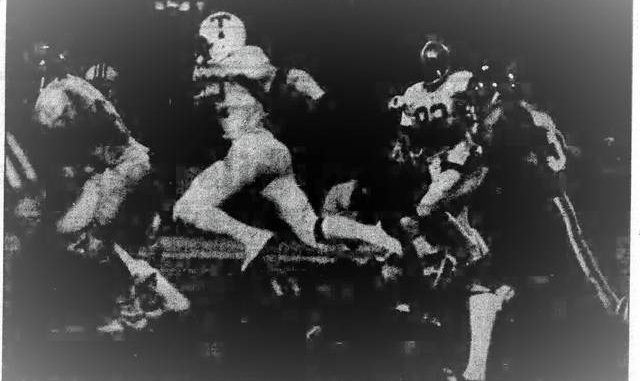
Nanticoke Area’s Harry Hamilton follows a block from Coughlin’s Ron Solt during the Big 33 Game at Wilkes-Barre Memorial Stadium in 1980. Organizers wanted the game back the following year, but it was awarded to Hershey.
Times Leader file photo
There was no second chance at making a first impression in 1980.
The area was fresh off hosting the Big 33 Game in July and wanted another opportunity to host in 1981, hoping to correct issues that made for a disappointing event on July 26. The request was going to be made to the PIAA Board of Control, which decided the game site.
The game at Wilkes-Barre Memorial Stadium drew only 2,976 spectators despite having three local players – Harry Hamilton, Bruce Kozerski and Ron Solt – and several others who would go on to play in the NFL. In June, the UNICO Game at the same venue drew about 4,000.
The main culprit for low attendance, organizers suspected, was the game was televised locally by WNEP. It was also picked up throughout the state by five other TV stations and one cable station. Plus, it was broadcast on eight radio stations. Organizers estimated the loss of 2,000 to 3,000 fans because of the statewide TV and radio exposure.
“There was no attempt at a blackout,” said Jim Davis, the Big 33 Game coordinator and Nanticoke Area athletic director. “I think they should have gave us a 100-mile (blackout) radius.
“I know we could have gotten more if it wasn’t for television. I strongly feel television made a difference.”
WNEP general manager Tom Shelburne Jr. said he would be in favor of a local blackout if the game remained in Wilkes-Barre, but it would depend on whether the two other local stations had interested in picking it up.
“I’d love it,” Shelburne said. “It’s very tough for us to give up prime time revenue of a local event. We lose money. But if it’s going to be televised, we want to do it.”
The game was moved from Hershey to Altoona in 1979 because of several issues including poor attendance.
Organizers were also considering using host families instead of dorms at Wilkes College for players to cut down expenses.
There was also the PIAA rule which limited seniors to two all-star games. Many of the Big 33 players – they were all from Pennsylvania at the time – would play in an all-star game in their local area and then have to chose between the Big 33 Game and the Pennsylvania Scholastic Football Coaches Association All-Star Game in Altoona. The Altoona game drew a similarly sized crowd.
Perhaps two games featuring the state’s top seniors was one too many, Big 33 organizers speculated. The Big 33 Game in 1979 in Altoona was played under the PSFCA umbrella.
Wilkes-Barre never received another chance. The game was moved back to Hershey in 1981 and then spent three years in Johnstown before returning to Hershey.
1921
Bob Horlacher, of Noxen, struck out 17 as Tunkhannock defeated Nicholson in a Wyoming Valley League baseball game.
1950
Bill Bennett, of Scranton, beat Ray Elston, of Harveys Lake, by a car length to win the 25-lap feature race at Bone Stadium in Pittston. Les Hoover, of Harveys Lake, was third.
1982
Bruce Stine, of Sweet Valley, recorded a hole-in-one at the Sweet Valley Golf Club.
Stine used a 7-iron to ace the 145-yard ninth hole. He was playing with Elmer Stevenson, John Stevenson and Steve Lecko.
tinyurlis.gdclck.ruulvis.netshrtco.de
مقالات مشابه
- این coronavirus 'حمل' را آزمایش نمونه ها در اطراف لندن
- طوفان گرمسیری کریستبل پیشرفت نسبت به ما سواحل خلیج فارس
- ساخت بسیاری از کار از خانه
- این مقاله بحث برانگیز را بخوانید و درباره مواد شیمیایی بیاموزید
- شرکت صادرات و واردات کالاهای مختلف از جمله کاشی و سرامیک و ارائه دهنده خدمات ترانزیت و بارگیری دریایی و ریلی و ترخیص کالا برای کشورهای مختلف از جمله روسیه و کشورهای حوزه cis و سایر نقاط جهان - بازرگانی علی قانعی
- شرکت صادرات و واردات کالاهای مختلف از جمله کاشی و سرامیک و ارائه دهنده خدمات ترانزیت و بارگیری دریایی و ریلی و ترخیص کالا برای کشورهای مختلف از جمله روسیه و کشورهای حوزه cis و سایر نقاط جهان - بازرگانی علی قانعی
- تأمین کننده تجهیزات مکانیکی و الکترونیکی - واردات
- بازسازی MLB باشگاه امید به نگه داشتن در حال توسعه چشم انداز بالا
- شرکت صادرات و واردات کالاهای مختلف از جمله کاشی و سرامیک و ارائه دهنده خدمات ترانزیت و بارگیری دریایی و ریلی و ترخیص کالا برای کشورهای مختلف از جمله روسیه و کشورهای حوزه cis و سایر نقاط جهان - بازرگانی علی قانعی
- نحوه استفاده دستگاه سانتریفیوژ